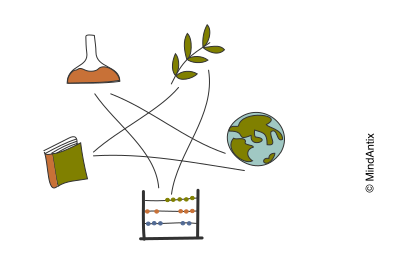Integrative learning, or the concept of combining multiple subjects or educational strategies, is not new. In the early 1800s, Johann Herbart, a German philosopher, psychologist and educator believed that only large units of subject matter are able to arouse curiosity and keep a young mind engaged in deep learning. Even when teaching a particular subject, he proposed teachers support the learning by correlating with and integrating other subject areas.
While his ideas gained ground in the US and other countries, social and economical changes in the early twentieth century led to a different pedagogical approach of teaching subjects independently of each other. Professors Mathison and Freeman write, “Industrial efficiency studies and scientific thinking characterized by objective, quantifiable measurement has led to the assumption “that complex tasks become more manageable (i.e. easier) once broken down into their so-called basic parts”” This approach of simplification-by-isolation soon became the predominant approach in teaching.
However, interest in integrative learning is rising once again in response to the more complex educational challenges of the 21st century. Professor Julie Klein, lists the three catalysts that are driving the trend back towards integrative learning. The first is “knowledge explosion” that over the last few decades has resulted in new areas of specialties like machine learning that didn’t exist before. The second is the complexity of problems we face today that require pulling solutions from multiple domains. Finally, the focus on educational reform is linking the two concepts with complementary pedagogies.
Our project based learning modules use an integrative and interdisciplinary approach to make for a more wholesome educational experience. Here are three things we typically do in each module:
Integration with Arts
Integrating arts into the regular curriculum has been found to improve test scores and reduce the academic achievement gap for economically disadvantaged students. In most of our sessions we typically use theater and improv exercises as warm-up games. Some of the improv games build the same cognitive thinking patterns that underlie creative thinking, which is likely why improv artists come up with more (and better) product design ideas than professional product designers.
Interdisciplinary
Our projects also integrate multiple subject areas like science and humanities. In our latest module, Imaginary Worlds, students are diving deeper into topics like natural and man-made habitats (architecture and geography), social hierarchy and norms (anthropology and anthrozoology) and mathematical symbols and operations (mathematics), as they work towards developing their own fantasy worlds.
Blended Learning
While students use the online platform during the module, they never spend the entire lesson on the computer. Each lesson also incorporates group activities or discussions, time for each student to think and work independently and also collaborate in groups.
We find that using the above approaches gives us a more well-rounded and engaging approach to teaching different concepts, including areas in STEM that some students find intimidating.

